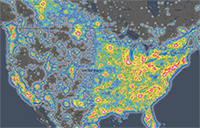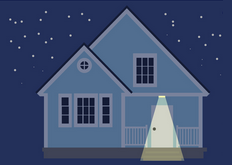Lighting Advice for Borrego Springs

You can help protect Borrego's night sky from the increasing problem of light pollution.
Making small improvements to lighting can lead to huge improvements in the quality of our dark night sky.
courtesy Yorkshire Dales UK National Park Authority
Sky Calendar: June — July 2025
By Dr. Randolph Baron
| May 22 Thurs | Conjunction of Moon and Saturn rising at eastern horizon around 2:48 a.m. |
| May 23 Fri | Conjunction of Moon and Venus rising at eastern horizon around 3:28 a.m. |
| Early June | Sunrise 5:37 a.m. PDT., sunset 7:50 p.m. PDT |
| June 1, Sun | Messier 13 well placed for observation, see note |
| June 1, Sun | Conjunction of Moon and Mars visible around 40 degrees above western horizon by 8:35 p.m. |
| June 11, Wed | Full Strawberry Moon rising 8:50 p.m. |
| June 18, Wed | Conjunction of last quarter Moon and Saturn rising in east around 1:06 a.m. |
| June 20, Fri | Summer solstice 7:41 p.m., summer begins for northern hemisphere |
| June 22, Sun | Conjunction of Moon and Venus rising in east around 2:58 a.m. |
| June 27, Fri | Good chance to see Mercury, 18 degrees above the western horizon at sunset |
| Early July | Sunrise 5:40 a.m., sunset 7:58 p.m. |
| July 10, Thurs | Full Buck Moon rising at 8:22 p.m. |
| July 16, Wed | Conjunction of Moon and Saturn rising in east around 11:18 p.m. |
| July 21, Mon | Conjunction of Moon and Venus rising in east around 2:57 a.m. |
| July 22, Tues | Conjunction of Moon and Jupiter rising in east around 4:14 a.m. |
| July 28, Mon | Conjunction of Moon and Mars visible around 8:34 p.m. 18 degrees above western horizon |
THE PLANETS THIS SUMMER
Venus is a brilliant morning planet all summer. Jupiter and Saturn are also morning
planets, rising earlier and earlier as the summer progresses. Saturn actually reaches
opposition on September 20. This means that the planet is on the opposite side of the
Earth from the sun, making it visible almost all night. Mars sets earlier and earlier
throughout the summer, becoming harder to see as it gets lost in evening twilight.
In early June, look up around 11 p.m., and you will see the constellation Hercules almost directly above. The most noticeable aspect of this constellation is called the keystone of Hercules and consists of a rhomboid figure of four stars. Use this diagram with binoculars to find the globular cluster Messier 13. While actually visible to the naked eye as a faint smudge, binoculars will reveal a glowing cloud. This cloud is the light from around 500,000 suns in a star cluster 25,000 light years away. That means that the light from this cluster entering your eyes has been travelling for 25,000 years…Wow!
The Perseid meteor shower will be active from July 17 to August 24, producing its peak rate of meteors on the morning of August 13. Over this period there will be a chance of seeing Perseid meteors whenever the constellation Perseus is above the northeast horizon, which is around 10 p.m. This meteor shower occurs when the Earth passes through the debris left behind by comet 109P/Swift-Tuttle in its orbit around the sun. A major disappointment this year will be our lovely Moon, just past full. This will drown out all but the brightest meteors. We love our Moon, but not during a meteor shower!

Sky Quality Meter Readings for Borrego Springs
A Sky Quality Meter (SQM) measures the luminance of the background night sky, in units of magnitude per square-arc-seconds. In essence, this indicates the magnitude that the integrated luminance over a square-arc-second in the same measure as used for stars. A good human eye, on a dark night, can see 6th magnitude or slightly darker. SQM readings over 20th magnitude indicate a dark sky with good visibility; and readings above 21st magnitude, which are common in the Borrego Springs area, represent truly excellent skies.
The readings presented here are from a location on St. Vincent Drive, about ¼ mile from the Borrego Springs High School; readings in more remote locations would be expected to be somewhat higher. The graph presents the reading from the previous night, with options to allow users to explore earlier data as well. The iconic marks on each reading indicate various impacting factors, such as moon brightness, estimated cloudiness, etc.



